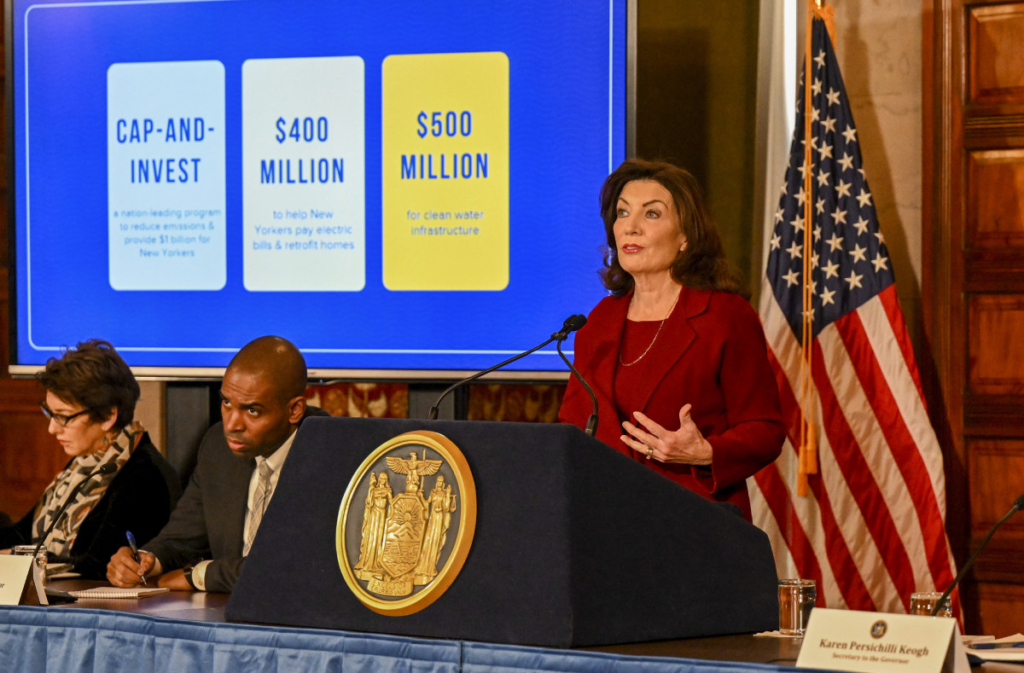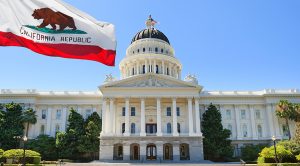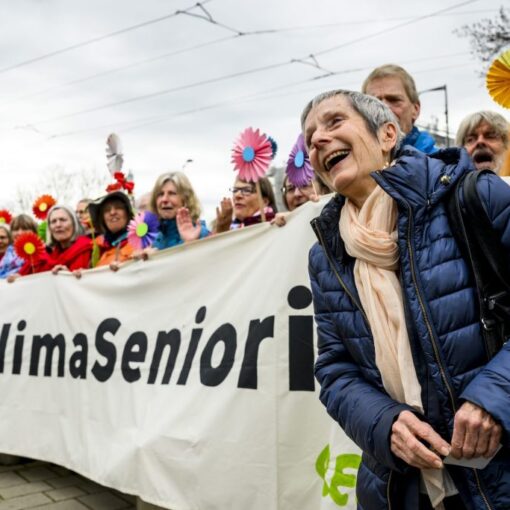In January, when Governor Kathy Hochul announced the creation of New York Cap and Invest–a regulatory program through which the state will set a continuously-decreasing cap on economy-wide emissions and issue emission credits in accordance with this cap– she touted the program’s potential for linkage with cap-and-trade programs in other jurisdictions. “Linkage” is a process through which a carbon trading program joins its market with another existing program. However, because of flaws in the cap-and-trade market of the Western Climate Initiative (WCI), the primary candidate for linkage, this move would drastically dilute the environmental effectiveness of New York Cap and Invest (NYCI). Instead of linking to the WCI immediately, NYCI should use the proposal of linkage as leverage to incentivize the WCI to resolve its own flaws.
The creation of NYCI follows the 2019 passage of the Climate Leadership and Community Protection Act (CLCPA), under which New York State’s electricity sector must reach zero emissions by 2040. The cap-and-trade program will require emitters of greenhouse gases to purchase credits at auctions, which will generate revenue that will be invested in clean energy and disadvantaged communities. NYCI will be the primary orchestrator of the reductions mandated by the CLCPA, which is why the stringency of the initiative is crucial.
NYCI, to be implemented by the Department of Environmental Conservation and the New York State Energy Research and Development Authority (NYSERDA), is currently in its early design stages. The CLCPA requires regulations to be in place by the end of the year, making NYCI’s linkage policy particularly relevant now, as certain regulations must be aligned with other existing cap-and-trade programs in order for linkage to be logistically possible down the line.
In this case, NYCI would presumably join the Western Climate Initiative, which already includes California and Quebec. These three cap-and-trade programs would hold communal auctions, and emission credits would be accepted in any of the jurisdictions.
Linkage is widely seen as a desired aspect of NYCI because of its projected benefits. It broadens the portfolio of emission reduction opportunities, which becomes a buffer against uncertainties like weather and economic activity that may create volatility in emission credit prices. For example, if extreme heat hit New York, energy usage and demand for emission credits would both increase dramatically. California’s energy usage would go undisturbed, however, which would reduce the effect on the emission credit market of this increase in demand. By expanding the jurisdiction, benefits of linkage also include reduced abatement costs, as well as fewer opportunities for emission leakage and free riders.
NYCI’s immediate linkage with WCI could also be seen as politically desirable. For example, Washington State recently began its own cap-and-trade program but chose not to link with WCI. Washington’s allowance prices were much higher than expected, for which some observers blamed the decision not to link. If initial allowance prices are also high in New York State, it could stoke political opposition to NYCI. Linkage could exempt NYCI from higher prices and political pushback.
For these economic and political reasons, the dominant opinion in the academic community is that linkage is generally advantageous to all parties involved. However, consideration of linkage between NYCI and WCI fails to acknowledge a crucial problem: chronic oversupply in the WCI emissions trading market.
California, the larger member of WCI, overallocated emission credits early on in their cap-and-trade program. According to California’s Legislative Analyst’s Office, more than 300 million allowances (equal to 200 million metric tons of CO2 equivalent) have been banked by emitters — equal to about one year’s worth of California emissions. By 2030, analysts project that emitters will have enough banked allowances to comply with the cap without further reducing emissions. This excess of banked credits puts California on track to exceed their 2030 emission goal by 30 percent.
The Independent Emissions Market Advisory Committee, which analyzes the performance of California’s cap-and-trade program, has frequently criticized this overallocation. Since 2018, they’ve recommended that the program regulators tighten the 2030 cap to correct the oversupply. Unfortunately, no reforms of the cap have been made. But a tightening of California’s cap to address oversupply is politically feasible: CARB, the administrative body that executes cap-and-trade, has the authority to tighten the cap, and recently reviewed a potential plan to do so.
While this reform would come with its fair share of resistance from California emitters, there is precedent for this kind of action. In 2021, the cap-and-trade program for fossil-fuel power plants in the eastern US, called the Regional Greenhouse Gas Initiative (RGGI), faced a similar oversupply of allowances as emission credits accumulated in the private bank. In response, RGGI announced they would make a reduction to their CO2 allowance budgets equivalent to the overaccumulation of allowances in the private bank. The reduction to the allowance budget is taking place over a five-year period.
The European cap-and-trade program, EU ETS, also suffered from an oversupply of allowances early in the program. In 2021, EU ETS administrators tightened the cap by reducing the number of banked emission credits. This move successfully restored the environmental effectiveness of the program without costing EU ETS its legitimacy or its authority.
Exacerbating California’s oversupply of credits is the fact that California’s cap-and-trade program has yet to be officially extended past 2030 by the state legislature. This regulatory uncertainty decreases confidence in the emission trading market in the eyes of California emitters. As in the years leading up to 2020, when the cap-and-trade program was due for an extension but had not yet been granted one, emission credits will be devalued and auction revenues will fall. It also weakens the incentive in the private sector to invest in long-term renewable energy projects. An extension of the program to 2050, as most other jurisdictions have planned, would require authorization from the state legislature.
If no changes are made by California, this combination of overallocation and political insecurity will nullify their cap-and-trade program’s intended benefits and they will fail to sufficiently reduce emissions. If NYCI links to WCI, however, these flaws would leak into NYCI’s program, too.
The first negative effect of linkage for NYCI would be environmental: research shows that by linking a cap-and-trade program like NYCI to one with a large bank of unused emission credits, like California’s, total emissions across both NYCI and WCI will be higher than in a scenario without linking. New York has set stringent emission reduction goals and will rely primarily on NYCI to meet achieve them. This will likely fail under linkage.
The second negative effect for NYCI would be economic, and by extension, environmental, too: the flagship provision of New York’s cap-and-trade program is the revenue the program will generate. Emission credit auctions are expected to generate between $1.6 and $3 billion annually, which policymakers pledge to use to finance the transition away from fossil fuels and to invest in communities that are especially affected by climate change. Linkage, however, will bring NYCI and WCI emission credit prices into alignment, with research showing that the resulting shared market price always settles closer to the jurisdiction with the larger economy. New York’s cap is more stringent than California’s, meaning NYCI’s prices without linkage would likely be higher than WCI’s. California’s economy, meanwhile, is larger than New York’s. The result is a perfect storm, in which prices are dragged down below those needed to generate NYCI’s expected auction revenue, rendering New York unable to make the environmental and climate justice investments they’ve promised.
With these effects in mind, it’s crucial that NYCI not pursue linkage with the WCI as long as California’s systemic flaws go unaddressed. But instead of isolating itself from the WCI, New York should leverage this situation to improve California’s environmental policy.
California would benefit economically from linking with New York: abatement costs for New York emitters would decrease compared to a no-linkage scenario, while opportunities to reduce emissions would increase. NYCI administrators should make linkage contingent on California cap-and-trade administrators tightening their cap to resolve their oversupply, as well as on extending California’s cap-and-trade program to 2050.
With these contingencies attached to linkage, California will have to renew the environmental effectiveness of their cap-and-trade program. And if these corrections are made, NYCI can pursue linkage with a reformed WCI, which would bring the benefits of linkage to New York residents as well as Californians.
Stockholm Environmental Institute recently recommended a similar strategy to Washington State as they also consider linking with WCI. SEI analyzed the jurisdictions’ cap-and-trade programs and respective economies and concluded that delaying full linkage in order to pressure California was beneficial to all parties, both environmentally and economically. When applied to New York’s economy and cap-and-trade program, this conclusion holds: the environmental effectiveness and stability of both WCI and NYCI can be improved if New York sets contingencies for linkage.
While the stakes around linkage are high, New York should see this as an opportunity to improve not only its climate policy, but California’s, too.

Grace Kaste
Grace Kaste is a rising sophomore at Columbia University, where she’s studying Economics and Sustainable Development. She is interested in using economics to design and evaluate environmental policy. She wrote this blog as an intern at the Sabin Center for Climate Change Law during the summer of 2023.





